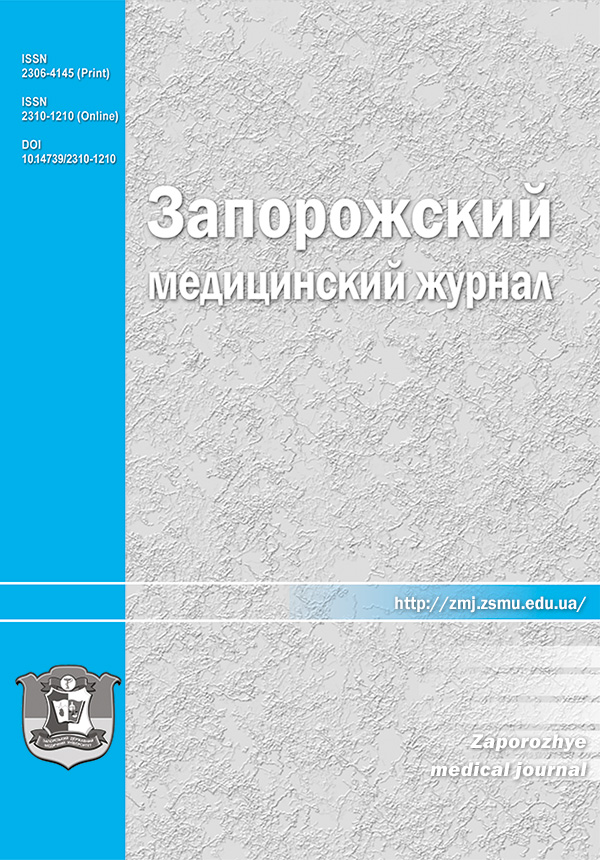Estimation of human metabolic age using regression and neural network analysis
DOI:
https://doi.org/10.14739/2310-1210.2021.1.224883Keywords:
metabolism, biomarkers, aging, neural networkAbstract
The aim is to develop the methods for assessing the rate of human aging by metabolic parameters (metabolic age).
Materials and methods. The study examined 120 subjects aged 40–80 years. All the people included in the study underwent the determination of plasma glucose concentration, lipid profile – total cholesterol, high-density lipoprotein cholesterol, low-density lipoprotein, very low-density lipoprotein cholesterol and creatinine as well as the standard glucose tolerance test. Validation of the panel of indicators was carried out using regression and neural network analysis.
Results. According to the study results, the standard error in determining the metabolic age using the multiple regression equation was 9.31 years, and using the neural network – 3.18 years.
Conclusions. The methods that we have developed for assessing the rate of metabolic aging showed sufficient (regression analysis) and high (neural network analysis) accuracy and can be used to assess the risk of metabolic syndrome, cardiovascular disease, and type II diabetes. The implementation of the proposed methods would not only identify people at risk for pathology, but also assess the effectiveness of treatment, prevention and rehabilitation measures.
References
Korkushko, O. V., & Shatilo, V. B. (2009). Uskorennoe starenie i puti ego profilaktiki [Accelerated ageing and paths to its prevention]. Bukovynskyi medychnyi visnyk, 13(4), 153-158. [in Russian].
Krutko, V. N., Dontsov, V. I., Zakharyashcheva, О. V., Kuznetsov, I. A., Mamikonova, О. А., Pyrvu, V. V., Smirnova, T. M., & Sokolova, L. A. (2014). Biologicheskii vozrast kak pokazatel' urovnya zdorov'ya, stareniya i ekologicheskogo blagopoluchiya cheloveka [Biological age as an index of human health level, aging and ecological well-being]. Aviakosmicheskaya i ekologicheskaya meditsina, 48(3), 12-19. [in Russian].
Belsky, D. W., Caspi, A., Houts, R., Cohen, H. J., Corcoran, D. L., Danese, A., Harrington, H., Israel, S., Levine, M. E., Schaefer, J. D., Sugden, K., Williams, B., Yashin, A. I., Poulton, R., & Moffitt, T. E. (2015). Quantification of biological aging in young adults. Proceedings of the National Academy of Sciences of the United States of America, 112(30), E4104-E4110. https://doi.org/10.1073/pnas.1506264112
Bürkle, A., Moreno-Villanueva, M., Bernhard, J., Blasco, M., Zondag, G., Hoeijmakers, J. H., Toussaint, O., Grubeck-Loebenstein, B., Mocchegiani, E., Collino, S., Gonos, E. S., Sikora, E., Gradinaru, D., Dollé, M., Salmon, M., Kristensen, P., Griffiths, H. R., Libert, C., Grune, T., Breusing, N., … Aspinall, R. (2015). MARK-AGE biomarkers of ageing. Mechanisms of Ageing and Development, 151, 2-12. https://doi.org/10.1016/j.mad.2015.03.006
Caballero, F. F., Soulis, G., Engchuan, W., Sánchez-Niubó, A., Arndt, H., Ayuso-Mateos, J. L., Haro, J. M., Chatterji, S., & Panagiotakos, D. B. (2017). Advanced analytical methodologies for measuring healthy ageing and its determinants, using factor analysis and machine learning techniques: the ATHLOS project. Scientific Reports, 7, Article 43955. https://doi.org/10.1038/srep43955
Cardoso, A. L., Fernandes, A., Aguilar-Pimentel, J. A., de Angelis, M. H., Guedes, J. R., Brito, M. A., Ortolano, S., Pani, G., Athanasopoulou, S., Gonos, E. S., Schosserer, M., Grillari, J., Peterson, P., Tuna, B. G., Dogan, S., Meyer, A., van Os, R., & Trendelenburg, A. U. (2018). Towards frailty biomarkers: Candidates from genes and pathways regulated in aging and age-related diseases. Ageing Research Reviews, 47, 214-277. https://doi.org/10.1016/j.arr.2018.07.004
Cevenini, E., Invidia, L., Lescai, F., Salvioli, S., Tieri, P., Castellani, G., & Franceschi, C. (2008). Human models of aging and longevity. Expert Opinion on Biological Therapy, 8(9), 1393-1405. https://doi.org/10.1517/14712598.8.9.1393
Crowson, C. S., Therneau, T. M., Davis, J. M., 3rd, Roger, V. L., Matteson, E. L., & Gabriel, S. E. (2013). Brief Report: Accelerated Aging Influences Cardiovascular Disease Risk in Rheumatoid Arthritis. Arthritis & Rheumatism, 65(10), 2562-2566. https://doi.org/10.1002/art.38071
Moreno-Villanueva, M., Capri, M., Breusing, N., Siepelmeyer, A., Sevini, F., Ghezzo, A., de Craen, A. J., Hervonen, A., Hurme, M., Schön, C., Grune, T., Franceschi, C., & Bürkle, A. (2015). MARK-AGE standard operating procedures (SOPs): A successful effort. Mechanisms of Ageing and Development, 151, 18-25. https://doi.org/10.1016/j.mad.2015.03.007
Salthouse, T. A. (2000). Aging and measures of processing speed. Biological Psychology, 54(1-3), 35-54. https://doi.org/10.1016/s0301-0511(00)00052-1
Steffener, J., Habeck, C., O'Shea, D., Razlighi, Q., Bherer, L., & Stern, Y. (2016). Differences between chronological and brain age are related to education and self-reported physical activity. Neurobiology of Aging, 40, 138-144. https://doi.org/10.1016/j.neurobiolaging.2016.01.014
Xia, X., Chen, W., McDermott, J., & Han, J. J. (2017). Molecular and phenotypic biomarkers of aging [version 1; peer review: 3 approved]. F1000Research, 6, Article 860. https://doi.org/10.12688/f1000research.10692.1
Downloads
Published
How to Cite
Issue
Section
License
Authors who publish with this journal agree to the following terms:
- Authors retain copyright and grant the journal right of first publication with the work simultaneously licensed under a Creative Commons Attribution License that allows others to share the work with an acknowledgement of the work's authorship and initial publication in this journal.

- Authors are able to enter into separate, additional contractual arrangements for the non-exclusive distribution of the journal's published version of the work (e.g., post it to an institutional repository or publish it in a book), with an acknowledgement of its initial publication in this journal.
- Authors are permitted and encouraged to post their work online (e.g., in institutional repositories or on their website) prior to and during the submission process, as it can lead to productive exchanges, as well as earlier and greater citation of published work (See The Effect of Open Access)

